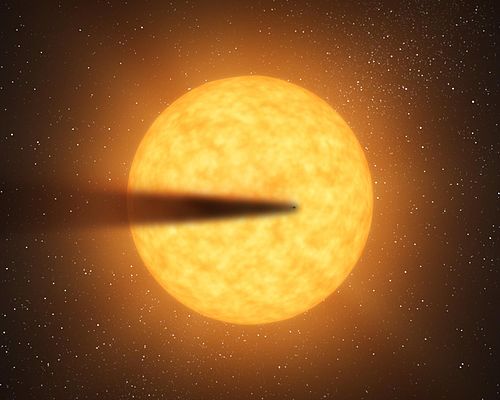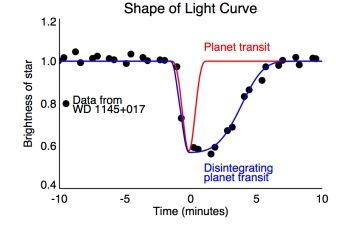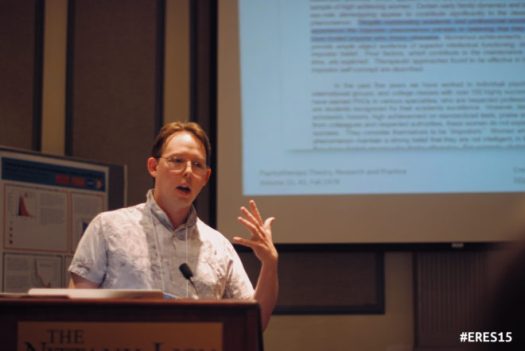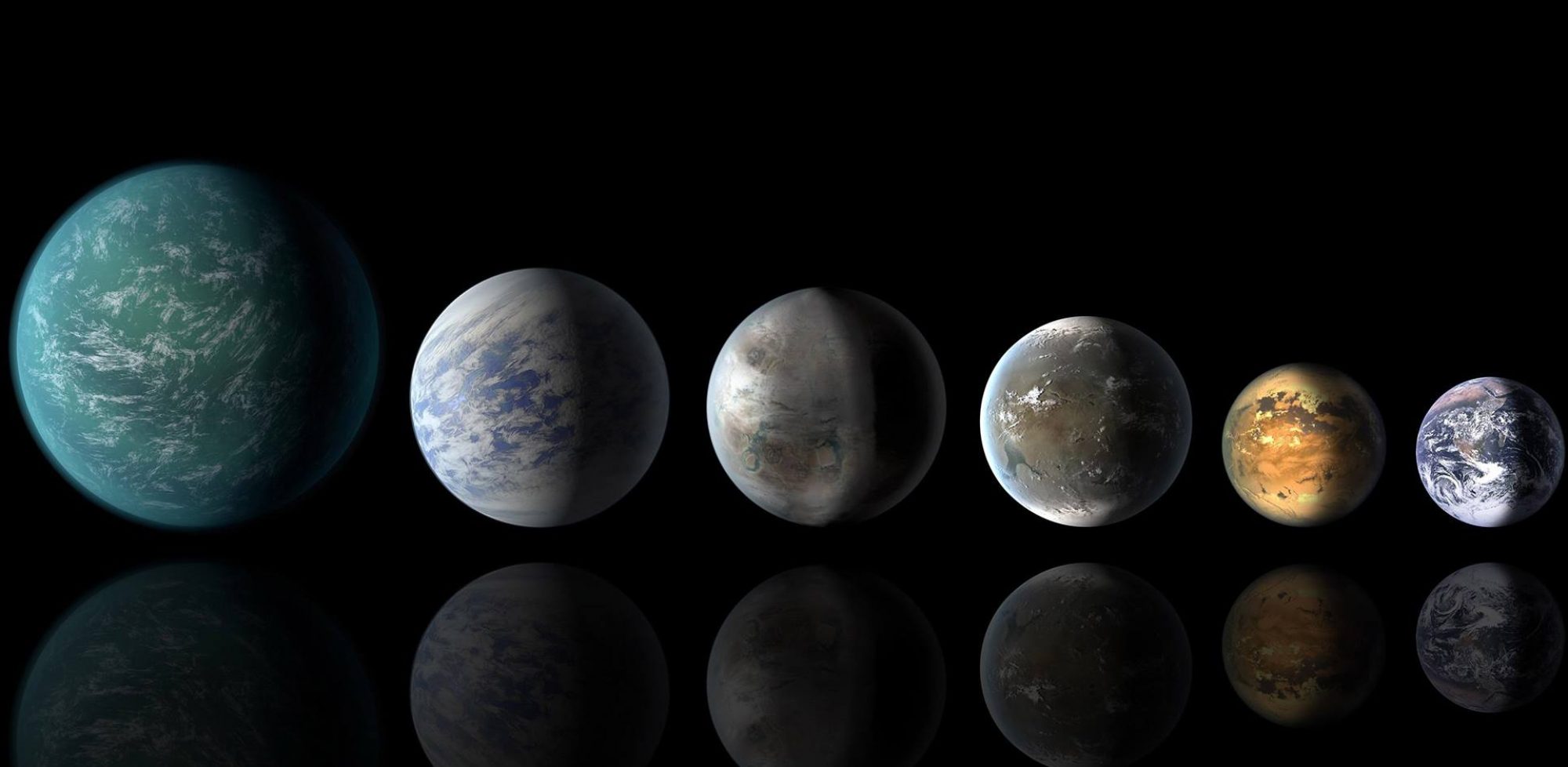
One of the seemingly quixotic goals of exoplanet scientists is to understand the chemical and geo-chemical compositions of the interiors of the distant planets they are finding. Learning whether a planet is largely made up of silicon or magnesium or iron-based compounds is essential to some day determining how and where specific exoplanets were formed in their solar systems, which ones might have the compounds and minerals believed to be necessary for life, and ultimately which might actually be hosting life.
Studying exoplanet interiors is a daunting challenge for sure, maybe even more difficult in principle than understanding the compositions of exoplanet atmospheres. After all, there’s still a lot we don’t know about the make-up of planet interiors in our own solar system.
An intriguing pathway, however, has been proposed based on the recent discovery of exoplanets in the process of being shredded. Generally orbiting very close to their suns, they appear to be disintegrating due to intense radiation and the forces of gravity.
And the result of their coming apart is that their interiors, or at least the dust clouds from their crusts and mantles, may well be on display and potentially measurable.
“We know very little for sure about these disintegrating planets, but they certainly seem to offer a real opportunity,” said Jason Wright, an astrophysicist at Pennsylvania State University with a specialty in stellar astrophysics. No intensive study of the dusty innards of a distant, falling-apart exoplanet has been done so far, he said, but in theory at least it seems to be possible.

And if successful, the approach could prove broadly useful since astronomers have already found at least four of disintegrating planets and predict that there are many more out there. The prediction is based on, among other things, the relative speed with which the planets fall apart. Since the disintegration has been determined to take only tens of thousands to a million years (a very short time in astronomical terms) then scientists conclude that the shreddings must be pretty common –based on the number already caught in the act.
Saul Rappaport, professor emeritus of physics at MIT, led the team that first identified a disintegrating planet around KIC 12557548, using data from transit light curves collected by the Kepler Space Telescope. The transits clearly did not indicate the usual small but detectable blockage by a solid body planet, but were nonetheless intriguing because they were showing that something interesting was crossing (or occulting) the star and trailing an orbiting object.
Rappaport said he was definitely not searching for a dust trail from a disintegrating planet.
“Nobody had suggested that and we weren’t looking for it,” he said. “It took us completely by surprise. Actually, after we found it, we spent many weeks trying to model it as a collection of solid bodies or something other than a disintegrating planet. But ultimately we had to face up to what it is – occultation by dust emanating from a planet.”
Four years after his first paper was published, Rappaport said he is now 99 percent certain that KIC 12557548 is a close-in planet slowly disintegrating via the emission of dusty materials, as are three other similar objects subsequently detected.
Rappaport said that speaking generally, measurements of the size of the dust particles coming from those decaying planets would provide very valuable information to scientists, as would any insights into their chemical composition. But he said that good data will be challenging to collect and equally difficult to interpret.

Unrelated to Rappaport’s work, Wright and a Penn State team, although with from the Arizona State University astrophysicist Steve Desch and others, have just sent a proposal into NASA to fund disintegrating exoplanet research using ground-based telescopes and the Hubble Space Telescope.
The collaboration originated at a meeting of the Nexus for Exoplanet Systems Science (NExSS), a five-year NASA initiative to bring together exoplanet scientists from a variety of disciplines with the goal of having them work together across disciplines. Organized by Mary Voytek, NASA’s senior scientist for astrobiology, it aims to bring the highly interdisciplinary model of astrobiology to the field of characterizing exoplanets.
“This is a project that really calls for, in fact requires, an interdisciplinary approach,” Desch said. “This is where astronomy and astrophysics meet planetary science and geology, and that should be a very fruitful place.”
Is a measure of the interdisciplinary effort, their team also includes Casey Lisse at the Johns Hopkins University Applied Physics Laboratory. He’s a comet scientist with a specialty in planet formation and astromineralogy.

Wright and Desch want to focus on the unusual transit signals from five stars — three M dwarf identified by Kepler, one a burned-out but super-dense white dwarf and other made famous last fall when a substantial and currently impossible-to-explain dust cloud was detected nearby it. All the known explanations to explain it were deemed inadequate, which led to (last option) suggestions that perhaps it was an alien “megastructure” or Dyson swarm built by intelligent beings.
Wright was part of the group trying to explain the vast cloud around the star — KIC 8462852 or “Tabby’s star,” named after Yale University post-doc and co-founder Tabetha Boyajian) and now suspects that a disintegrating planet could be a source (though he says that Desch was the first to make the case.)

The object that orbits a white dwarf star at a distance about the same as between Earth and the moon. When its discovery was announced last year by Andrew Vanderburg of the Harvard-Smithsonian Center for Astrophysics in Cambridge, Massachusetts, he said that something unique had been found: “We’re watching a solar system get destroyed.”
The planet (or planetesimal) orbits its white dwarf, WD 1145+017, once every 4.5 hours. This orbital period places it extremely close to the super-dense star, and that speeds the shredding and evaporating of the planet. But makes it a theoretically easier target to observe. Each time it orbits is a potentially detectable transit to be captured and studied.
White dwarf stars have also served as an earlier destination for those looking for information about potential insides of planets, but via a more indirect approach. Because of their greatly heightened gravity, white dwarfs have surfaces covered only with light elements of helium and hydrogen. For years, researchers have found evidence that some white dwarf atmospheres are polluted with traces of heavier elements such as calcium, silicon, magnesium and iron. Scientists have long suspected that the source of this pollution has been asteroids or, what was then theoretical, a small planet being torn apart.

Another prime target for disintegrating-planet research is the first one identified, KIC 12557548 b. Because it is so small — no bigger than Mercury — it’s an object that would never be detected by telescopes looking for transits across a star. It is, after all, 1500 light years away. But the dust cloud is much bigger and blocks as much as 1 percent of the light from the star every time it orbits. To compare, our Jupiter would block about the same amount of the sun’s light in a similar scenario seen from afar.
The team leaders said that while their goal is to collect data that will help them understand the grain size and chemical composition of the dusty planetary remains, they also aim to refine the observing and spectrographic techniques for future observations — most especially on the James Webb Space Telescope.
The JWST, which launches in 2018, will have the capacity to collect information about the disintegrating planets that current instruments cannot. But time on the telescope will be very costly and competitive, so Wright said the team will be doing the groundwork needed to make disintegrating planets an appealing subject for research.
“A lot of the observational technique has to be invented,” said Wright. “JWST will be prime time for new science, but before that we need a lot of ground-based pre-study to make the case.”
The proposal also calls for extensive modeling of the dynamics of how dust grains would be released under the pressure of intense gravity and radiation pressure.
Coincidentally, a paper that models exoplanetary interiors authored by Li Zeng of the Harvard-Smithsonian Center for Astrophysics (CfA) and others, has been accepted for publication by The Astrophysical Journal.
Making sure it first could reproduce the Preliminary Reference Earth Model (PREM) — the standard model for Earth’s interior — Zeng and his team modified their planetary interior code to predict the structure of exoplanets with different masses and compositions, and applied it to six known rocky exoplanets with well-measured masses and radii.
They found that the other planets, despite their different masses and presumably different chemical makeup, nevertheless all appear to have a iron/nickel cores containing about 30% of the planet’s mass, very similar to the 32% of the Earth’s mass found in the Earth’s core. The remainder of each planet would be mantle and crust, just as with Earth.
The model, however, does not add new information about the observed make-up of exoplanet interiors. That’s where the disintegration of close-in exoplanets just might come in.

